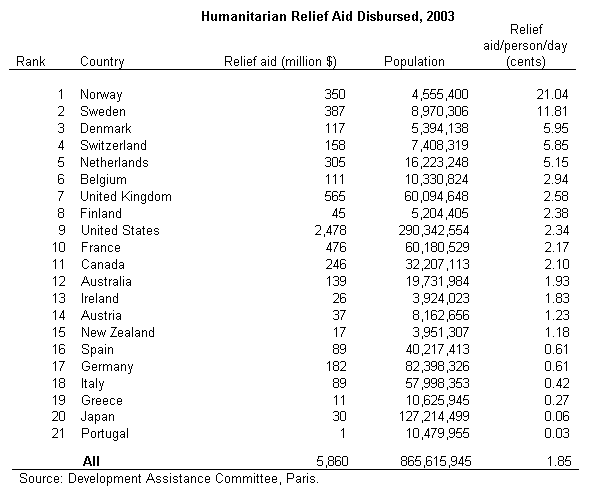U.S. Generosity
David Roodman, a Research Fellow with the Center for Global Development, writes,
Thought the below might interesting in light of the spat about whether the U.S. is generous. Also see Foreign Policy for an excellent graphic showing how stingy the U.S. is, even counting private giving.
Today, December 29, President Bush defended the U.S. as “a very generous, kind-hearted nation,†which gave some $2.4 billion of relief aid in 2004, 40% of all relief aid. Was he right? Actually, the figures were probably for 2003, since 2004 is not over and the data have not been collected. For 2003, his numbers are right. But does that make the U.S. most generous? The U.S. gave 2.3 cents/person/day of humanitarian relief aid in 2003, ranking it 9th among 21 rich countries. See below.

Of course, ranking ninth out of 190-odd counties in the world isn’t bad.
Still, I’d argue that the data in the table are misleading, in that the calculations define “humanitarian aid” very narrowly. For example, the U.S. spends more than all the countries above it on the chart combined on its military. Military expenditures, from the perspective of those of DAC’s persuasion, are not “humanitarian” at all. That’s true even though the U.S. military has ousted tyrannical regimes in Iraq and Afghanistan, spent billions rebuilding the infrastructure of those states, done humanitarian rescue work around the globe, and so forth. I can’t find their methodology on their page, but I strongly suspect the vast amounts the U.S. spends in supporting the U.N., the multiple billions it gives to Egypt and Israel, and similar funds are excluded from the calculations.
I’ve asked David for information on the table’s methodology. I’ll update further if I get clarification.
Update (1809): My suspicions in this seem to have been confirmed. David cites the 2002 REPORTING DIRECTIVES FOR THE CREDITOR REPORTING SYSTEM and notes
Data for this database are supplied by each of the donors each year, and I don’t think they’re really audited, which reflects the fact that the donors fund the DAC too. So in the end, it might be the case that relief aid is what the donors say it is. The numbers I sent you are for “Line I.A.1.5 Emergency and distress relief (code 070)” and definitely line up with the figures Bush cited today.
Looking at the guidelines, though, it appears that relief is narrowly defined within four categories:
Grants are transfers in cash or in kind for which no legal debt is incurred by the recipient. For DAC/CRS reporting purposes, it also includes debt forgiveness, which does not entail new transfers; support to non-governmental organisations; and certain costs incurred in the implementation of aid programmes.
Grant-like flows comprise a) loans for which the service payments are to be made into an account in the borrowing country and used in the borrowing country for its own benefit6, and b) provision of commodities for sale in the recipient̢۪s currency the proceeds of which are used in the recipient country for its own benefit.
Loans are transfers for which the recipient incurs a legal debt and repayment is required in convertible currencies or in kind. This includes any loans repayable in the borrower̢۪s currency where the lender intends to repatriate the repayments or to use them in the borrowing country for the lender̢۪s benefit.
Equity investment comprises direct financing of enterprises in the aid recipient country which does not (as opposed to direct investment7) imply a lasting interest in the enterprise. Other official flows are official sector transactions which do not meet the ODA/OA criteria.
Much–if not most–of the money the U.S. spends, ostensibly at least, to help others is not included in these categories.






Of course, US military spending is humanitarian! I am sure that the 15,000 civilians killed in Iraq during the US military’s control of the country would have a different view of “humanitarian” aid.
The vast majority of those killed have been killed by terrorists, not the U.S. Further, how many have been killed by governments propped up with “humanitarian” aid from the U.N. and other well-meaning contributors?
Interesting post James. What struck me is the per capita rankings. Where is China or Russia? Also, food aid is not included nor is medicine. The dollars spent for such aid is, however not the actual supply.
As noted above, food aid to the tune of almost $1 billion per year usually isn’t included, especially by those intent on bashing the U.S. And aside from military actions in which snide critics can cite civilian deaths, the U.S. military is routinely involved in humanitarian rescue and assistance efforts, just as it will be in Asia. That’s a huge expense also not considered.
The problem with statistics is that they can be bent to serve any individual agenda…
The aid statistics are far more complex than a simple comparison to other countries’ generosity.
The same can be said for military spending. The U.S. has far more responsibilities, even U.N. directed responsibilities, than any other country. Further, Americans demand that we spend more to keep our troops well supplied, and as safe as possible.
40% of all aid is very significant; something to be very proud of. We are a good country, with good intentions, doing much good in the world.
I don’t know where all of the self-hate originates on the left…
James – I wrote my dissertation on humanitarian aid following natural disasters, and the figures on which I based my research show that the US is astonishingly generous when it come to humanitarian relief – with 36% of the global total in 2002 and 41% in 2003. The numbers I used came from OCHA, the UN body that comes under the remit of Jan Egelend, the very man who accuses the US of stinginess. This post has the details.
Whichever way you present the data the US comes out looking good. With the lions share of humanitarian aid donations each and every year you guys deserve a vote of thanks from the more sane of us foreigners.
Interesting that they don’t count military spending as part of emergency relief, since there are going to be a huge number of U.S. military personnel and equipment in the Indian Ocean for the near future, at taxpayer expense. None of that will probably show up on the balance sheet.
Further, there’s no mention of the amount of private giving by U.S. individuals to aid organizations like the Red Cross, etc.
The discussion appears to cover only government aid. How about private aid? I got the impression from Mr. Egelands’s comments that voluntary contributions don’t count for much in his estimation.
The private aid issue is important: Americans are very generous personally, and will be giving through church groups, the Red Cross, UNICEF, and the like.
Beyond that, the fact that we spend as much on our military as we do frees up other Western European nations to be more generous with their public funds.
Ever notice how when the news shows the Red Cross in disaster areas it’s referred to as The *American* Red Cross? When’s the last time you ever saw the french or german red cross in action anywhere?
Where are the wealthy Muslim contries such as Saudi Arabia? Since they have very small populations it wouldn’t take many dollars of aid to push them to the top of the list. But they are not there at all.
James, I think you can make a case that a lot of U.S. assistance, broadly understood, is not being counted. I wouldn’t necessarily agree, understand, but it can be done. But I think the way to do it is a bit different from what you have written. These categories–grants, loans, investment, etc.–are pretty broad. They’re just asking whether the recipient has to pay money back and if so on what terms.
What you could argue, I suppose, is that security aid, like we are providing in Afghanistan, training soldiers and such, is not being counted but should be. There is actually a debate right now among DAC members (the rich countries) about whether to change this. But one shouldn’t assume without data that counting it would radically change the picture.
At the Center for Global Development, I run a project called the Commitment to Development Index (www.cgdev.org/rankingtherich). It’s a collaboration with Foreign Policy magazine. We rate 21 rich countries on the how much their policies help or hurt poorer countries. We do count troop commitments in Afghanistan, the NATO intervention in Kosovo, the relative ease with which people from poor countries can come to the U.S. to work and send home money, and our relatively open trade policies. We also factor in policies that affect the global environment, technology creation and dissemination, and investment flows.
In doing all this we control for size since it doesn’t make sense to ask Denmark to give as much aid as the U.S. where one could argue that the U.S. should give as much per GDP or per person as Denmark. Similarly, one can’t expect Denmark to import as much from poorer countries as the U.S., but can argue it should have trade barriers as low.
The point is to do in a serious way what you are arguing for–looking at the bigger picture. In the 2004 edition, the U.S. ties with France, Germany, and Norway for 7th place (out of 21)–not terrible but not where I think the leader of the free world should be.
David,
I agree with the premise of your research. I disagree, though, that only direct cash payments should be counted. Certainly, the entirety of the U.S. military budget shouldn’t be counted, either, in that much of it is clearly not “humanitarian aid.” However, the use of U.S. military transports to move critical goods, U.S. peacekeepers, funds given to the U.N. for its humanitarian operations, and so forth should certainly be counted. The countries above the U.S. on your list are “stingy” with their services even if they’re generous with the cash.
Why don’t I see any Middle Eastern Countries? With all their revenues they should be donating at least something.
The effect of private aid is bound to be de minimis. Americans give plenty, of course, but I’d be shocked if more than a quarter of that aid went abroad.
My research on the web was only perfunctory, but this little essay from 2000 about private sources of foreign aid in the US looked interesting.
The estimations early on are that foreign aid from private sources easily exceeds foreign aid from public sources.
http://www.americanoutlook.org/index.cfm?fuseaction=article_detail&id=1183
In doing all this we control for size since it doesn’t make sense to ask Denmark to give as much aid as the U.S. where one could argue that the U.S. should give as much per GDP or per person as Denmark. Similarly, one can’t expect Denmark to import as much from poorer countries as the U.S., but can argue it should have trade barriers as low.
And herein is the crux of the dispute. The U.S. is not Denmark. Our highest tax bracket is what, 39 percent? Compare that with the European countries and you get a skewed picture of giving that favors countries that basically demand money from their own citizens so they can piss it away to the U.N., etc.
In the U.S., citizens give more of their own money because they don’t have Uncle Sam squeezing their pocketbooks to take it away from them. Naturally a socialist country is going to look better than a capitalist country, because we don’t rely on our government to be a big nanny Santa Claus.
Comparing Denmark’s governmental giving per capita to the U.S.’s governmental giving per capita is just as flawed as any other system the U.N. has because it represents fundamental political differences in how citizens are taxed, how their money is spent, and how charity functions.
I suggest we American tell them to kiss our ass. They can find their own air planes, helicopters and ship in order to get the aid distributed. Let’s see then who is screaming…